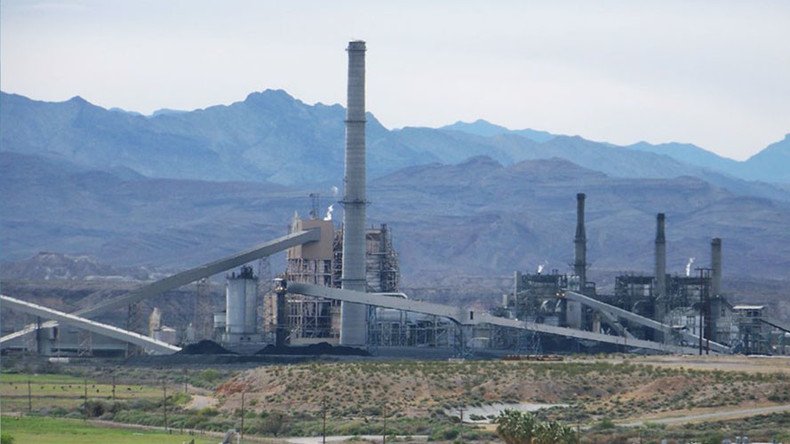Nevada coal power plant shut down amid pressure from Native American tribe

Southern Nevada’s oldest coal-fired power plant will cease operation after a half-century of production. The Moapa Band of Paiutes tribe has long blamed the plant for pollution and waste as the cause of health problems for people in the area.
The closure comes as Nevada lawmakers are soon to debate relying more on solar energy. NV Energy, the state’s dominant electric utility, will flip a switch to disconnect the Reid Gardner Generating Station from the electric grid on Thursday, according to AP.
Reid Gardner coal plant closes in NV - while nearby 250MW solar comes on line https://t.co/Gep0pDWBCp via @reviewjournal
— Roger Aines (@RogerAines) March 16, 2017
The plant is situated 40 miles north of Las Vegas. Three of the four units were permanently shut down in December 2014.
The utility company plans to decommission and eventually demolish the plant as part of its plans to get out of the business of burning coal. It is replacing the 250 megawatts produced by the plant with a mix of natural gas and renewable energy, according to the Las Vegas Review Journal.
NV Energy says Reid Gardner station will be demolished but no job cuts. Employees will be transferred to other plants. @News3LVpic.twitter.com/BwO3oZpjaN
— Faith (@FaithNews3LV) March 16, 2017
The Moapa Band of Paiutes long sought the closure of the Gardner plant, which opened in 1965 on the banks of the Muddy River. Tribe members blame pollution from the facility’s smokestacks and coal-ash dump for illnesses and death at the nearby reservation.
No health studies have definitively linked medical problems among the tribe’s roughly 300 members to the power plant next door, but Paiute officials have said research is underway.
The tribe sued NV Energy in 2013 over pollution from the plant arguing it had violated the federal Resource Conservation and Recovery Act and the Clean Water Act. The company settled in 2015 agreeing to pay the tribe $4.3 million. The tribe said it planned to use the money to fund a wellness center and install air pollution monitors, according to tribal chairman Darren Daboda.
Daboda said he noticed a difference since the plant scaled back its operations in 2014. He said the air over the reservation, with has 300 members, smells better and “the fly ash has gone down,” according to the Las Vegas Review Journal.
State lawmakers also spurred the move in 2013 when they passed a bill that sought to end the company’s reliable on coal to power Southern Nevada.
#ICYMI: Clean-energy advocates mark the closure of the Reid-Gardner coal plant in Moapa. More here: https://t.co/eE7LQ21jgE via @Renew_NV
— Jessica Scott (@jscottsolar) March 16, 2017
On Friday, tribal leaders and other dignitaries will gather for a commissioning ceremony for a new solar project.
The 250-megawatt Moapa Southern Paiute Solar Project is expected to deliver enough electricity to the Los Angeles Department of Water and Power to supply up to 93,000 homes. It is the first-ever utility-scale solar power plant to be built on tribal land.
Thank you to the Moapa Band of Paiutes for letting us on your land to learn more about your solar project pic.twitter.com/9vWfV019pE
— NCL (@NVconservation) September 15, 2016
The coincidental timing of Friday’s ceremony was not lost on the Sierra Club, which fought alongside the Moapa Paiutes against the coal plant which then-US Senate Majority Leader Harry Reid once called a “dirty relic.”
“Reid Gardner powered down just as Nevada is taking its place as a national clean energy leader,” said Elspeth DiMarzio, campaign representative for the environmental group in Nevada, according to AP. “The state now employs more than 20,000 people in the clean energy and energy efficiency industries, and they are proving they can reliably and affordably power our state without coal.”
The deserts of Nevada receive more sun than any state in the US which makes it a prime spot for developers to construct solar photovoltaic or thermal generating stations. More than one-fifth of Nevada's electrical generation comes from renewable energy sources, according to the U.S. Energy Information Administration (EIA).
Battery-powered revolution: #Tesla storage plant to power 15K Californian homes https://t.co/7bAbe7gyDVpic.twitter.com/pOqkvphjTM
— RT America (@RT_America) January 30, 2017
State lawmakers will soon debate a number of energy-related issues, including the state’s renewable portfolio standards and efficiency programs. One of the bills would require that 80 percent of the state’s energy come from renewable power sources by 2040 (right now, the requirement is 25 percent by 2025).
A key issue in this debate will be storage. Because solar and wind can be intermittent — the sun is not always shining, and the wind is not always blowing — those renewable sources often are backed up by a fossil fuel: natural gas.
In the future, large-scale batteries that store renewables could replace natural gas. Batteries are currently expensive, compared to cheap natural gas.












